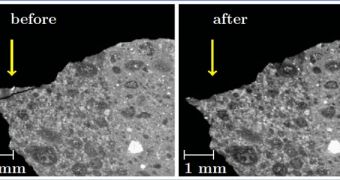According to the conclusions of a new international study, it would appear that the most likely origin for the loose material covering small asteroids is rock weathering. Temperature-induced fragmentation also plays a role in generating this type of debris, which is also known as asteroid soil. Astronomers have been trying to figure out the origins of this material for many years, thus far to no avail.
The new investigation was conducted by experts with the NASA Solar System exploration Research Virtual Institute (SSERVI) at the Ames Research Center (ARC) in Moffett Field, California, the Observatoire de la Côte d’Azur, the Hopkins Extreme Materials Institute at Johns Hopkins University, Institut Supérieur de l’Aéronautique et de l’Espace, and the Southwest Research Institute (SwRI).
One of the most interesting conclusions was that temperature fluctuations caused by sunlight falling at particular angles over a moving asteroid can cause rock fragmentation, a process through which minute pieces of the object come off, and are deposited on its surface. Regular rock weathering contributes to increasing the amount of available “soil” as well.
This study was conducted in order to explain the origins of regolith, a loosely-bound association of materials astronomers have detected on the surface of small asteroids, less than one kilometer (half a mile) in diameter. Details of the research will appear in the April 10 issue of the top journal Nature.
In the past, scientists argued that impacting microscale meteorites were the most likely culprit for the synthesis of regolith. These impacts were believed to be strong enough to produce some amounts of dust, some of which fell back to the surface of the target asteroid. However, gravitational simulations of this hypothesis have revealed that space rocks do not have enough mass to capture ejected dust.
“This insight will help us to interpret astronomical observations of asteroid surfaces in terms of the underlying bedrock, not contaminated by in-falling debris from elsewhere. In other words, we should expect to see the same materials in the regolith that make up the larger boulders and rocks of an asteroid,” says ARC SSERVI chief scientist, David Morrison.
The international team used an X-ray scanner to measure the thermal fatigue of different types of meteorites, both before and after the samples underwent a series of wild temperature variations. Thermal fatigue is a term used to describe the growth patterns and nature of cracks that appear on all asteroid fragments as a result of the aforementioned cycles.
“We find that rocks larger than a few centimeters break up faster by thermal fragmentation induced by extreme temperature variations between day and night, than by micrometeoroid impacts,” explains the lead author of the new study, Observatoire de la Côte d'Azur astronomer Marco Delbo.
The new study also helps explain the apparent lack of fragile carbonaceous-type near-Earth objects (NEO). These space rocks have a very sensitive internal structure, which is disintegrated when the object moves closer to the Sun. “The Sun acts like an oven; it heats up space rocks producing internal stresses that, over time, break them apart,” explains SSERVI expert Simone Marchi, from the SwRI.
The new conclusions will undoubtedly be tested by 2025, when NASA is scheduled to launch a mission to retrieve an NEO from Earth's neighborhood, and place it in a stable orbit around the Moon. Astronauts will then harvest samples from the surface of the space rock, allowing geologists back on Earth to test a large number of scenarios related to asteroid formation theories.

 14 DAY TRIAL //
14 DAY TRIAL //